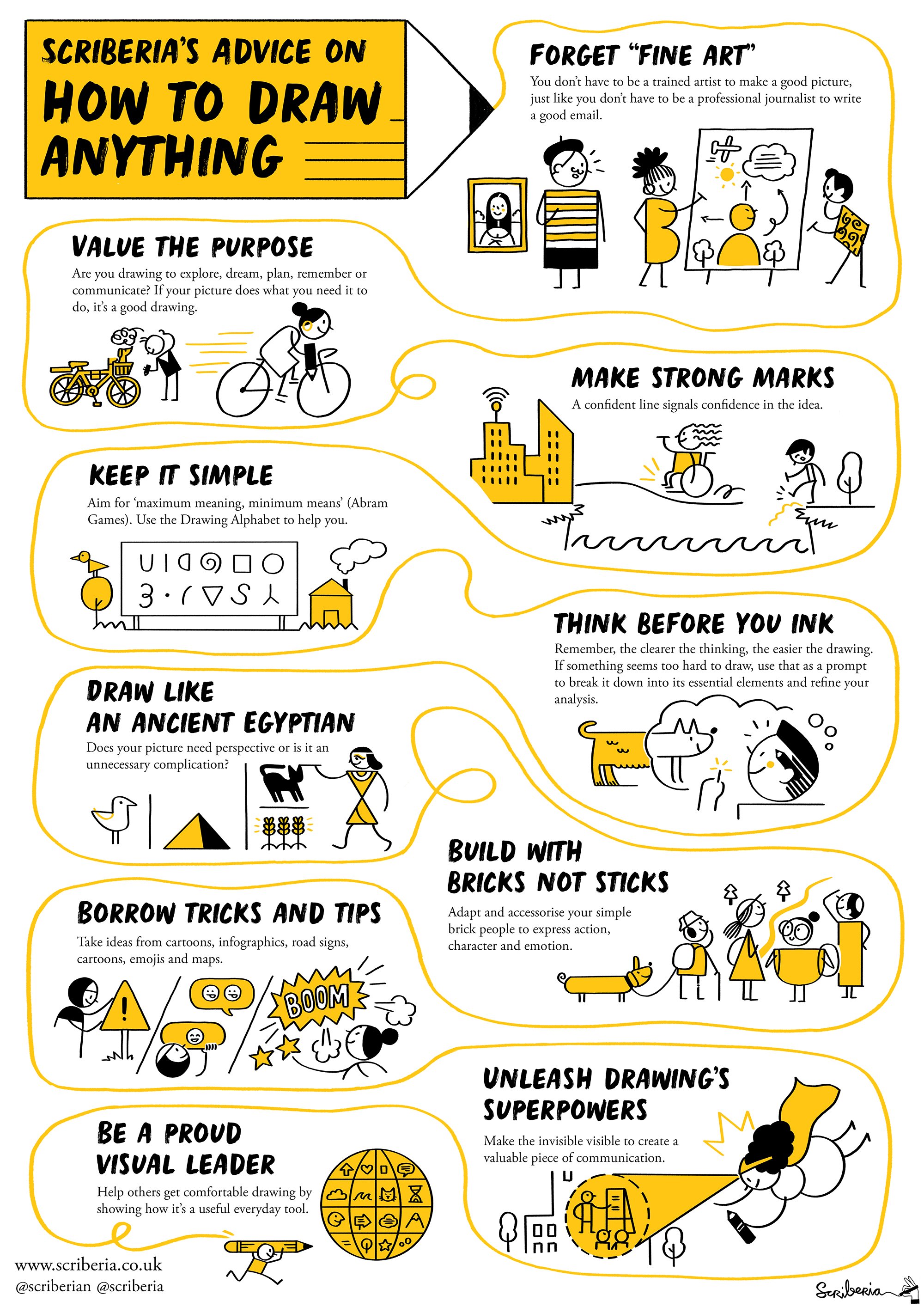We know from daily experience at Scriberia that if you can handwrite the letters of the alphabet, you already have the technical ability to draw anything. What’s more, we believe that everyone has the potential and the right to use drawing as a valuable everyday tool for life and work, just like writing.
All we need to get started with making drawing part of our practice is the foundation set of attitudes and techniques that we explored in the first workshop. We experimented with some handy tools that help simplify the process of drawing, and take away some of the infinite number of options we face when we stare at a blank page with a pencil in our hand. We used the Drawing Alphabet to shift the focus back towards pure communication, and Brick figures to quickly express human emotion and behaviour and really ramp up our visual storytelling abilities. We’re going to keep using those tools and principles as we move through this course.
The key ideas for this week are summarised in the poster for you to download. (You might like to print it and stick it by your workspace to help you build your practice.) And to go deeper on these themes, you’ll find wisdom and inspiration in Scriberia’s How to Draw Anything book.
Ultimately, nothing can replace getting stuck in with regular practice. So here are your homework challenges. Enjoy! And don’t forget to share some of your homework with us on Jamboard before next Friday morning.
“Better the rudest work that tells a story or records a fact, than the richest without meaning.”

Limbering up with the drawing alphabet
Warm up your hand and eye, and focus your mind on the principles behind the Drawing Alphabet, by taking a moment each day to follow one or two of these short animated tutorials. No need to upload these ones to Jamboard.
“Do you have hands? Excellent. That’s a good start. Can you hold a pencil? Great. If you have a sketchbook, open it and start by making a line, a mark, wherever. Doodle.”

Homework Challenges
Use your superpowers
Drawing gives us superpowers to make the invisible visible and the intangible tangible. We can use it to show how things look from above and below, zoom in and out, x-ray solid structures, and show smells, sounds, thoughts and emotions. This challenge is to make a picture of something that reveals more about it than a plain photograph. And to do that by using techniques we’re all familiar with from anatomy diagrams, geography textbooks, instruction leaflets, comic strips and the like. For example, you could create an explainer diagram for your TV remote control. Or you could draw your apartment block to show the different kinds of music being played by its occupants. Or you might make a picture of your pet and its thoughts. Remember to keep your drawing clear and simple, and use scale, detail and the weight of your line to reveal what’s most important.
Make a field study
In this video Cathy sets you a challenge to make a study of five familiar things and turn them into simple, clear and economical images you can dash out at speed. This exercise is a great form of drawing practice. It’s also a helpful way of building up your internal stock of useful pictures for life and work.
Make a party scene
How do you draw simple character forms that tell a story, create a scene, and compel your audience? In this video Dan shows you how. And he sets you the challenge to make your own brick people party.
Play with faces
We’re all familiar with emoticons these days, so we know how the simplest marks can convey a huge range of moods and feelings. What’s more, as a communicator, the ability to show human emotions visually enables you to tell a deeper and more engaging story. Dan invites us to experiment with drawing faces to express moods and personalities.












